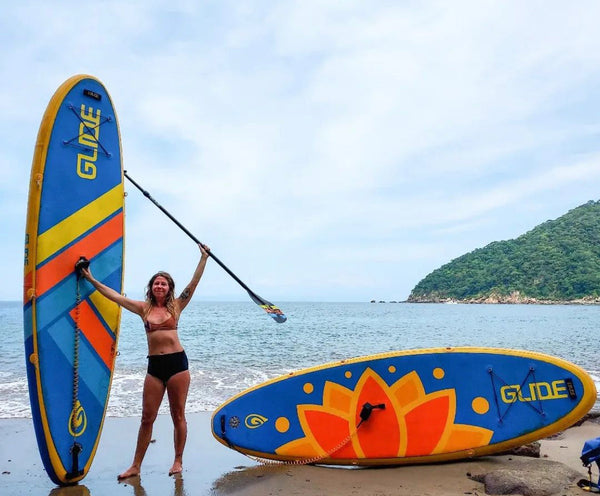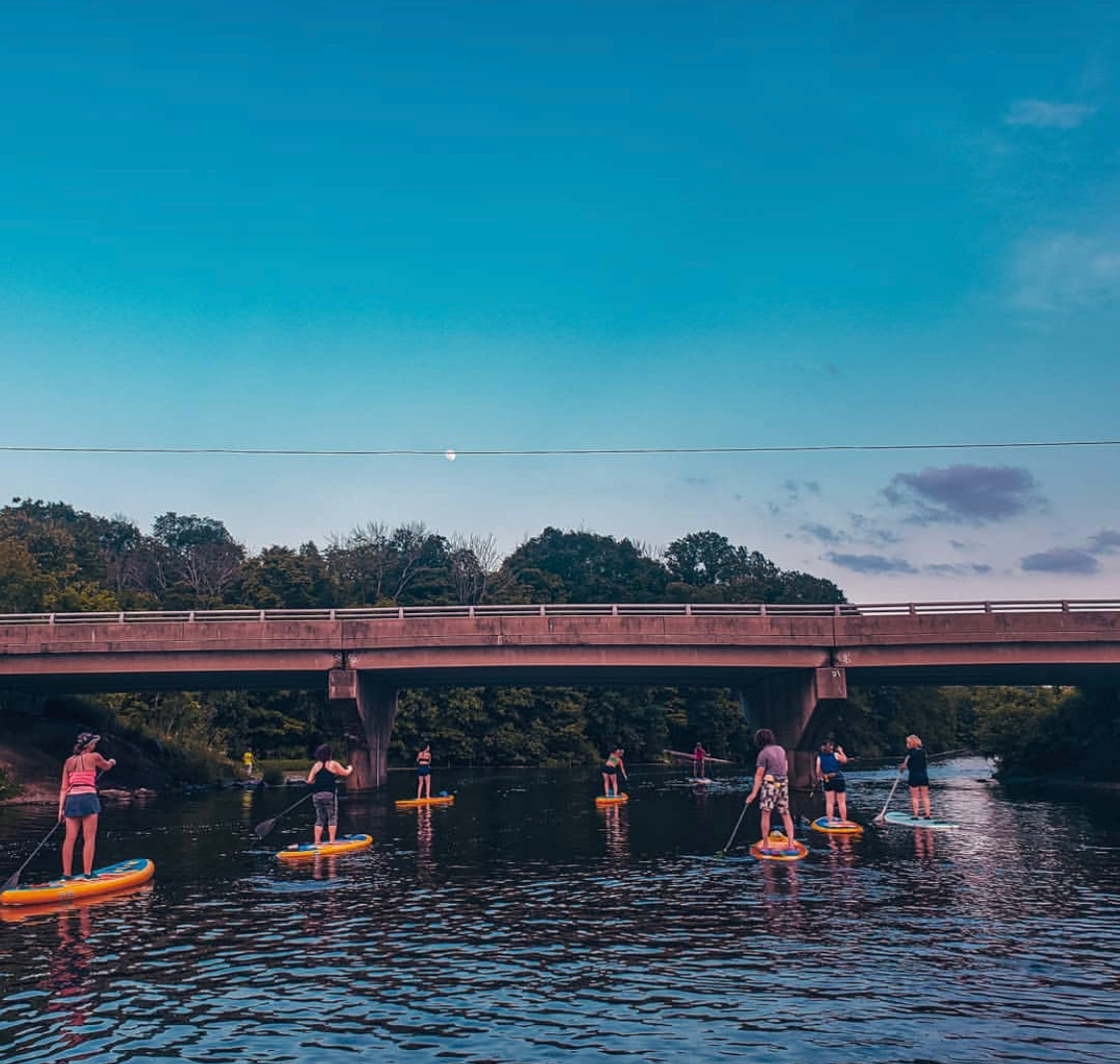
Are Inflatable Paddle Boards Harder to Stand on?
Are inflatable paddle boards harder to stand on? Not at all. This guide explains why high-quality inflatables offer excellent stability, what factors matter most, and how to choose a SUP that makes standing easier for beginners and pros alike.
One of the most common questions beginners ask is whether inflatable paddle boards are harder to stand on than hard boards. The truth? No — in many cases, inflatables are actually easier to balance on. Thanks to their extra width, thickness, and forgiving deck, modern inflatable SUPs provide stability that helps new paddlers gain confidence quickly. This guide explains why inflatables are stable, how they compare to hard boards, and what factors affect balance.
Table of contents
If you're thinking about getting an inflatable paddle board but wondering whether it’s harder to stand on compared to a hard board, you're not alone. This is one of the most common questions from first-time paddlers.
The short answer is: a high-quality inflatable paddle board is just as easy to stand on as a hard board—and in some cases, it’s even easier. Let’s break down why, what factors matter most, and how to choose a board that gives you the best stability for your style of paddling.

Understanding Paddle Board Stability
When it comes to standing up comfortably on a paddle board, stability is everything. Several factors determine how stable a board feels under your feet:
Board Width
Wider boards are more stable. Look for widths between 32–36 inches if you prioritize easy balance or plan to bring a kid, dog, or cooler.
Board Thickness & Volume
Most inflatable SUPs are 6 inches thick, creating a high-volume platform that floats you higher and resists wobble. More volume = more forgiveness.
Board Shape
All-around boards with rounded noses are the most forgiving. Touring and racing shapes (pointed noses) are tuned for speed and tracking; they can feel “tippier” at rest but very stable once moving.
Rigidity
Inflate to the recommended PSI (often 15–20 PSI, sometimes higher) so the board feels rock-solid underfoot. Under-inflation is the #1 reason an iSUP feels wobbly.
Fin Setup
A larger center fin or a 2+1/tri-fin setup improves tracking and side-to-side stability, which helps beginners stand with confidence.
Deck Pad & Foot Placement
A full-length, grippy deck pad prevents slips. Stand centered on the carry handle with feet shoulder-width apart, knees soft, and core engaged.
Inflatable vs. Hard Boards: How They Really Compare
Advances in materials and construction mean high-quality inflatable SUPs now match or surpass hard boards in real-world stability.
Inflatable Advantages
-
Forgiveness in chop: The slight give of an iSUP damps tiny waves and boat wake, creating a smoother, less “twitchy” feel.
-
Durability: Military-grade PVC and heat-welded seams resist dings, cracks, and shoreline bumps—great for new paddlers and travel.
-
Comfort: Softer deck = kinder on knees, shins, and pets’ paws—useful when you’re learning or paddling with family.
Hard Board Advantages
-
Direct feel: Some paddlers like the ultra-firm feedback for racing or precise surf maneuvers.
-
Slight speed edge: In glassy conditions, an epoxy board can have a touch more glide.
Bottom line: If you're a beginner, an inflatable board is not harder to stand on. In many common conditions (lakes, bays, mellow rivers) it can be easier and more comfortable.
If you want a deeper comparison later, see: Inflatable vs. Hard Paddle Boards
Factors That Make Inflatable Boards Easier to Stand On
1) Width & Outline
A broader outline increases the stable platform under your feet. Glide’s all-around and fishing models use generous widths for extra forgiveness.
2) Construction Quality
Woven drop-stitch cores and multi-layer PVC produce exceptional stiffness without unnecessary weight. Glide’s AeroMatrix™ construction is purpose-built for rigidity and stability.
3) Proper Inflation
Under-inflated = soft and wobbly. Inflate to spec before every session. Quality inflatables are engineered for high-pressure safety.
4) Fin Choice
If you’re struggling with balance, try a larger center fin or run all three fins on a tri-fin setup for added directional stability.
5) Your Technique
Look at the horizon (not your feet), keep knees slightly bent, and stack shoulders over hips. Small, frequent strokes help you stabilize faster than big, slow ones.
Set-Up Checklist for Maximum Stability
-
Pressure: Pump to the recommended PSI before paddling. Re-check after 5–10 minutes; air warms and expands.
-
Fin install: Make sure the fin(s) are fully seated and secured—loose fins cause surprising wobble.
-
Deck pad: Keep it clean and sand-free for ideal traction.
-
Load placement: If carrying gear, center the weight and keep heavy items low.
-
Leash & PFD: Wear a leash so the board stays with you and a PFD for safety and confidence.

Technique Tips That Make Standing Easier
-
Kneel first: Take 4–6 strokes on your knees to feel the board track.
-
Feet to handle: Place both feet where your knees were—over the carry handle—then rise.
-
Micro-adjust: If the nose plows, step back an inch; if the tail drags, step forward.
-
Brace stroke: When you wobble, slap the blade flat on the water like a tripod leg; it stabilizes instantly.
-
Wind sense: Start with light winds and paddle into the wind first so the return is easy.
Brand-new to SUP? This primer helps: Beginner’s Guide to Stand-Up Paddleboarding
Why Glide Inflatable SUPs Stand Out for Stability
At Glide, we design for real-world conditions, not just showroom floors. Every inflatable model is:
-
Built with woven drop-stitch cores for maximum rigidity
-
Reinforced with heat-welded seams for long-term durability
-
Tuned with optimized widths and balanced outlines for confident footing
-
Shaped for easy tracking and glide, even at beginner speeds
From the beginner-friendly O2 Retro to the ultra-stable O2 Angler (great for fishing, pets, and heavy loads), Glide boards make standing, paddling, and progressing easier for every size and skill level.
Browse the lineup: Glide Inflatable Paddle Boards.
Frequently Asked “Stability” Questions
Do inflatables feel bouncy?
Not when properly inflated. At the right PSI, a quality iSUP feels surprisingly rigid. If it feels soft, add air.
What width should I choose?
-
Under 180 lb: 32–33 in all-around is great.
-
180–240 lb: 33–34 in for extra comfort.
-
240+ lb or pets/gear: 34–36 in or a fishing/utility model.
Single fin or tri-fin?
A tri-fin setup can feel more planted for beginners. As you improve, experiment—some paddlers prefer a single larger fin for glide.
Can I do yoga or bring my dog on an iSUP?
Absolutely. Many paddlers find the soft deck and width of inflatables ideal for yoga and pet passengers. (Dog owners often start here: What to Bring on a Paddle Boarding Adventure

Final Thoughts on: Are Inflatable Paddle Boards Harder to Stand On?
So, are inflatable paddle boards harder to stand on? A high-quality inflatable paddle board is absolutely not harder to stand on—and in many scenarios, it’s easier. Width, construction, and correct inflation work together to create a stable, confidence-building platform that welcomes beginners and rewards seasoned paddlers.
If you’re just starting out, the forgiving feel of a good iSUP removes the intimidation factor. You’ll spend less energy fighting for balance and more time refining your stroke, exploring new water, and actually having fun. If you’ve been paddling a while, inflatables unlock adventures hard boards struggle with—flying to new destinations, hiking into alpine lakes, or navigating shallow rivers without worrying about dings.
Choose a width that matches your body and goals, pump to spec, use the fins that suit your water, and keep your eyes on the horizon. Do that, and you’ll discover what thousands of paddlers already know: today’s inflatables are stable, capable, and ready for anything.
Ready to build skills fast? Beginner’s Guide to Stand-Up Paddleboarding
Ready to stand tall on Day One? Shop Glide Inflatable Paddle Boards
FAQs
Are inflatable paddle boards stable?
Yes. Inflatables are typically wider and thicker than hard boards, which makes them very stable for beginners.
Are hard paddle boards easier to stand on?
Not necessarily. While hard boards give direct feedback from the water, most beginners find inflatables more forgiving and less intimidating.
Why do inflatables feel more stable?
Because they displace more volume, sit slightly higher on the water, and often come in widths of 32–34 inches or more.
Do inflatable boards bend or wobble underfoot?
Quality inflatables built with woven drop-stitch and fused rails are extremely rigid. Cheap boards with thin PVC may flex, which hurts stability.
Is it harder for heavier paddlers to balance on inflatables?
Not if the board is properly sized. Boards with higher weight capacities and widths of 34–36 inches offer excellent stability for larger paddlers.
Can I do yoga or fish on an inflatable SUP?
Yes. Their wide platforms make them popular for SUP yoga and fishing, where balance is key.





